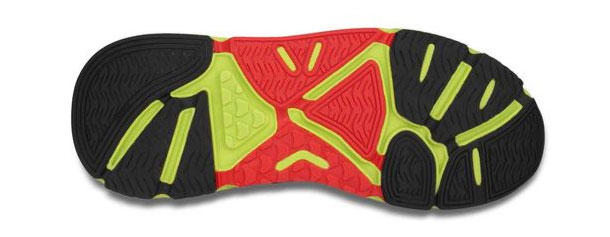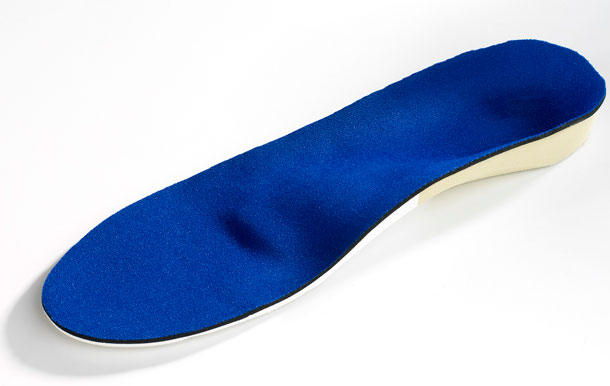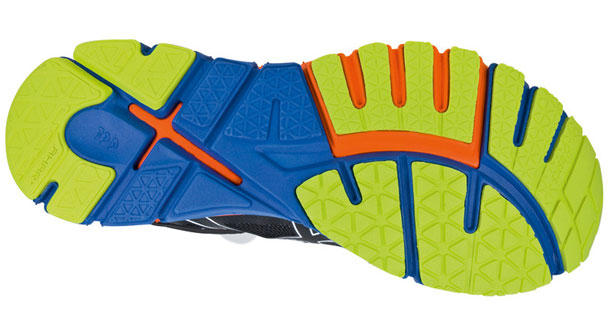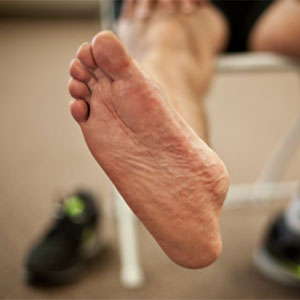Run shoe levers and footbeds
The first two installments of this series have generated a lot of thought and comment that both parallel and diverge from mine (Slowtwitch readers are not shy about this, which I'm glad of).
What I've written so far is my best guess as to where footwear is going. No real secret that my response is Danger, Will Robinson! when I run up against barefoot running themes, but it's ironic that I often get accused – by adherents of that movement – of behavior in which I don't engage, and in which they do engage.
Let me state, again, as I did in each of my first two series installments, so that there is no misunderstanding, I am not suggesting a style of shoe for everyone. I am not saying that a structured shoe is your answer. It certainly is the answer for me and what I champion are structural themes that actually work, as opposed to those that are less effective (e.g., midsole wraps instead of medial plugs). But for neutral runners, with good footfalls, do you need these features? No. What I have heard from the barefoot movement is that everybody is a candidate for their preferred style of footwear (or lack thereof). I not only vehemently dispute that, I think it's dangerous. And negligent.
It is this movement, and train of thought, that I am glad to see fading from running. I view running as I do cycling and every other sport: We should be very wary about doing, teaching, advocating, selling anything that is not in sync with how the best in our sport execute their technique.
That established, I'm writing articles about exciting new footwear themes and technologies and I have in large measure the barefoot, natural, and minimalist movements in running to thank for this. As noted in my previous installment, I have been calling for low-ramp shoes for decades and I cited my own plea here on Slowtwitch, more than a decade ago, for such shoes. The shoes I'm running in today are what I asked for years before Chris McDougal published Born to Run and it's highly unlikely I would have gotten these shoes absent this book and the movement that flowed from it. Low-ramp is not new and novel, it just took a hiatus during the running boom.
We can also track the attention to proper running form, proper footfall, to this movement. Did the natural running community develop, or was it the first to draw attention to, these techniques? Not even close. As Steve Magness points out in his short history of run form, we have known for a long, long time – coaching it for a century, writing about it for more than a half-century – how to run properly. It's just not been anything many people have been interested in hearing. What we've heard instead for a generation is that everybody will naturally adapt to his own best running style. Fine. You'll also naturally adapt to your best cooking style, given enough time. But you'll get there much more quickly with a cookbook and a home ec class. Magness points out that just after the running boom we studied the great unwashed mass of runners and developed shoes for their style. We did this rather than teach the masses how to run properly. As Jordan Rapp put it in an email to me, footwear makers are now focused on, "How do we help people run correctly" as opposed to "How do we accommodate people who run incorrectly."
It took the natural running movement to bring this to the forefront. We are now in a new upsurge in running. When you get 25,000 people to come out to a 5k and throw paint on each other, that's a good sign. Many of these people will realize that a 10k or half-marathon, paint or no paint, is a pretty interesting idea, completing their fall into the sport we know and love. Today we have footwear to sell them that is low-ramp, that has forefoot cushion, and these people are hearing about proper run form. I don't think any of this would have happened without the natural running movement.
Stiffness where we didn't previously want it
All that said, I'd like to focus on a couple of things that seem to me a real departure from how we’ve viewed shoes in the past. I wrote in my last installment about fulcrums, and about the need to resist this idea that shoes need flex in their midsections, so that they can twist, or whatever it is these designers think shoes should do. Facebook comments appending to this last installment make mention of Karhu’s attachment to the idea of the fulcrum, a theme of theirs for a generation. If you look at where this feature sits in the shoe, it’s in that very place other companies have sought to, at time, make a shoe flexible or minimal.

Hoka, likewise, not only resists adding flex to this part of the shoe, it actively works to keep the shoe stiff! This shoe will not flex in the very place that other shoes are made to flex. The shoe presents, as a gift to the runner, a rigid lever to grant a mechanical advantage during the push phase. This is not just a minor departure from the way footwear was conceived and designed in the past.
This presents a nice segue into a topic that always gets me into real trouble! The segue occurs because this feature above — stiff mid-sections rather than twisty, bendy mid-sections — helps make a great platform for that 8-letter dirty word, the Orthotic!

Custom orthotics
This is where things get tricky, because there is no good clinical evidence that orthotics work, and there is even evidence that they harm. Those who are anti-orthotic and who are up on the literature are probably going to cite the research and writings of Benno Nigg, PhD, University of Calgary, who concludes that orthotics prevent neuromuscular and anatomic inputs necessary for a proper and natural walk or run cycle.
I’ve seen studies that conclude that orthotics both decrease and increase running economy, and I’ve seen the occasional study that touts the advantages of orthotics but, really, they’re rare and outnumbered by those that cannot find any statistical evidence of value.
In some studies, all athletes were made to run in the same shoe model. In some cases, orthotics were simply inserted into a runner’s existing shoe. In no cases could I find a careful consideration of what shoes actually work well with orthotics. Specifically, neutral shoes are horrible candidates for orthotics.
I also found a lot of studies that focused on specific problems, but generally not my problems. I do not have and have not suffered from plantar fasciitis, chondromalacia, patellar tendonitis. My problems tend to be lateral/medial, specifically IT band problems and what I’ve self-diagnosed as medial collateral ligament pain. I have found literature saying that orthotics is a viable treatment for IT Band syndrome, but I’ve also found studies saying that corrective neuromuscular approach is a viable alternative.

It seems to me that there are so many variables that it's tough to reach a scientific consensus. It's like testing the validity of self-coaching versus professional coaching, or self-diagnosed versus professional bike fitting. Does it not matter how good the coach or fitter is? The quality of the fitter's equipment? Whether or not the bikes underneath these riders were appropriate to begin with?
But I don't want to simply infuse doubt into the literature as a permission slip to discard the literature. If studies lose some relevance because the protocol was not ideal, that probably mirrors our own inability to find a solution because our own pathway to the perfect orthotic solution is not ideal.
In my own case, I just simply cannot run successfully for any period of time without orthotics. I have been told by a number of people, any number of times, that if I invested the time in strengthening muscles and investing in a neuromuscular solution I would find orthotics unnecessary. Again, I find it ironic that in describing my own experienced I'm accused of prescribing it for everyone, yet these very same people offer me the advice and solution they invariably give to everyone.
What I do find, in my own case, is that I must be very choosy who molds my foot, what kind of orthotic I'm running in, and in what shoes my footbeds nest. And, I have to "behave" and by that I mean the sorts of technical elements that attend good running, and the way I plant my foot in a number of axes, is critical. In short, it's like marriage. Theoretically it's a good idea, but if you marry the first girl you date, and you don't make behavioral changes to adapt to this new reality, you're not likely to find bliss.
But what is the alternative? If you're going to "solve" the "ache" of loneliness you're going to have to date, and that is going to yield, almost certainly, some false starts and bad experiences before you find ultimate success. If you're going to "solve" the "ache" of IT Band syndrome or whatever it is that ails you, then you're entering a journey that may take time, and may end in false starts and frustrating experiences. It's a lot like bike fit. First, you have to be positioned properly, and that's analogous to someone holding your foot in the right position when casting it for a running orthotic. A good bike fitter, or orthotic maker, will faithfully replicate a bike fit – or a foot fit – in his "solution." But if he's a bad definer of your position, garbage in, garbage out: you'll end up on a bike that's got your crappy fit session faithfully executed. Or, if an orthotic molder, he'll faithfully make orthotics that replicate the bad molding job he did when casting your foot.
Finally, you can end up with a great cast of your foot, and a great orthotic, but in a bad shoe, just like a great set of fit coordinates can be established aboard a bike completely wrong for those coordinates. I have had great luck with Brooks Adrenaline and, most recently, Hokas, as platforms for my orthotics, because these shoes offer a substantial base and a lot of great medial support to uphold the orthotic. There's a ton of force coming down on that orthotic – multiples of your body weight. This is why I use a specific running orthotic (my preference is the Amfit system bit it is not the only good one). There are other systems that are great for custom cycling shoe footbeds, such as Footbalance and Sidas. But a running shoe orthotic takes up way too much volume to be used in a cycling shoe, and a cycling footbed is not nearly robust enough to work as a running orthotic.
One thing about shoe choice: Orthotics seem to me to add a bit of drop. So, if you start with a shoe that has quite a bit of drop and you stick an orthotic in there, I suspect you're adding more drop. This is one reason I've been an advocate for low-drop shoes for decades before any of them even existed. The orthotic I use nested in a 6mm or lower drop shoe is a nice solution.
I am not at all surprised that the literature has not found any statistical benefit to orthotics for runners. I therefore only lukewarmly recommend orthotics and I would never recommend them unless you feel you have a specific symptom that needs fixing urgently, and you haven't found success elsewhere.
I think Dr. Nigg describes perfectly the problem:
"Orthotics and insoles very often do have an effect. In some cases these effects are positive, in some cases they are negative. The major problem with orthotics, insoles and shoes is that different subjects or users react different to such an intervention. Subject reactions to orthotics are not consistent. They are subject-specific. An orthotic with a medial support, for instance, may produce an increase of knee joint loading in one person and a decrease in another person. And it is difficult if not impossible to predict when the effect will be positive (e.g. a reduction of knee joint loading) and when negative."
I had occasion to describe my personal experience with orthotics, and he commented thusly:
Your story that you described is an excellent example for what I found in my research. You are one more that supports my concept of subject-specific interventions.
He did give one product-specific clue. He said that a review of the literature showed that positive outcomes with orthotics just about always occurred with soft orthotics, which I take to mean orthotics milled out of an EVA blank (such as those I use, and this is my experience as well, having tried just about every type). He speculates that an orthotic must pass a comfort test – must get past our "comfort filter." This jibes with my own experience, with the proviso that, in my case, an orthotic did not work if it didn't provide a substantial lift in my arch. Going from no orthotic to an orthotic means, for me, 3 or 4 days of walking around in a no- or low-drop shoe prior to my first run. But if you aren't more comfortable with the orthotic than without after the first couple of days, it was a failed experiment.
This is why Dr. Nigg "is not for or against orthotics. However, it is very difficult to select the right shoe, right insert, right orthotic." I could not agree more.



